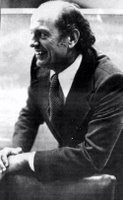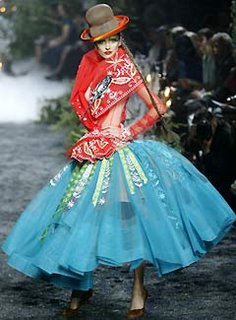 Angel Rama's introduction to Arguedas's Señores e indios is perceptive about the challenge Arguedas faced in adapting an essentially social realist novelistic form to his own purposes.
Angel Rama's introduction to Arguedas's Señores e indios is perceptive about the challenge Arguedas faced in adapting an essentially social realist novelistic form to his own purposes. Rama suggests that Arguedas resorted to "a type of return to the accumulative system corresponding to earlier stages in the development of the genre" (35). Instead of the "organic unity" of the nineteenth-century novel, in which plot and character develop mutually and linearly, Arguedas's novels turn around "the accumulation of intense and sudden 'illuminations,' structured and synchronic visions of an apprehension of the real that retains all its possible manifestations" (36).
In other words, Western narrative proceeds by the elimination of possibilities, as the plot puts options to characters who are unable to move on without making a decision between them. By contrast, Arguedas maintains a sense of the possible--perhaps better, the always present virtual--implicit in a landscape, human and natural, that always goes beyond the individual and his or her decisions. Or rather, bringing together the two forms, one Western the other closer to an indigenous worldview, Arguedas presents:
a double operation: on the one hand, a causal chain of actions and characters comes together in line with the traditional requirements of realist narrative; on the other, unexpected 'illuminations' arise, that may or may not be connected to the sphere of the action, but which enable another development and another interpretation that the author sees as more profound, and more effective as literature. (37)Hence, for Rama, Arguedas offers a model of literary transculturation. More precisely, he offers his literature as a model of an ideal transculturation that might be an object lesson for Peruvian culture as a whole. Because "if it were possible in literature, then it might also be possible in the rest of the culture" (15).
So Arguedas's is a transculturation in reverse: it is not that his novels are the products of transculturating forces; it is that they themselves aim to force the production of transculturation elsewhere.
It's a little strange, however, that Rama should make this eloquent case for the importance of Arguedas's literary project in the introduction to what is a collection of anthropological essays. Indeed, Rama says little to illuminate the thirty eight short pieces that his own essay supposedly introduces.
Perhaps Rama's silence owes something to the fact that however much Arguedas may have struggled with literary form, however much his novels were a series of more or less inconclusive, even unsatisfactory, experiments, he seems not to have struggled in the same way with the conventions of anthropological writing.
There is very little sign in Señores e indios of the tensions that would later in the twentieth century lead to the myriad critiques and auto-critiques that have both plagued and invigorated the discipline of Anthropology. For all the autobiographical elements in Arguedas's writing (for instance in "Canciones quechuas") or the more journalistic accounts in which he writes of his own observations (such as "Andahuaylinos, alemanes y amueshas"), there is no point at which he produces anything like a self-conscious or self-reflexive approach to the business of studying Peruvian customs and culture.
There is in fact hardly anything like an explicitly theoretical approach. And though he declares that he is avoiding theory in what are mainly semi-popular essays (destined for newspapers rather than specialized journals), Arguedas is happy enough to endorse a straightforwardly positivist and empiricist, even scientistic, attitude to his object of study. In a discussion of Andean music, for instance, he deplores those who are ignorant of even "the rudiments of the science devoted to the study of this aspect of the culture" (210). Such ignorance leads, he tells us, to the adoption of "bluntening and deforming measures" (210) that increase the likelihood of "what we can perfectly properly call falsifications" (209).
And in what does such falsification consist? In an inability to tell the original from a copy. This is what anthropological science can provide: a distinction between the true and the false; between model and imitation. Here, however, a whole can of worms opens up. For it turns out that the "copy" that Arguedas is denouncing involves a return to what one might otherwise suggest would be an "original" pre-Hispanic, "Incaist" cultural identity.
Arguedas insists that this Incaist return to some pre-Hispanic form not only denies the continuity between Inca civilization and contemporary indigenous culture, but also thereby loses sight of the "authenticity" of that culture, much of which is in fact "richer and more extensive than the ancient, because it has assimilated and transformed excellent instruments of expression that come from Europe, and that are more perfect than the ancient" (216). This leads him to the counter-intuitive stance of defending transculturation on account of its authenticity and originality, and denouncing nativism for its artificiality and secondariness.
But above all: why and on what grounds denounce this transculturation, the product of the current vogue for indigeneity among an intellectual elite in Lima, but not the former transculturation, that has already taken place in the Andes?
 Why denounce the "abyss between the original and the imitation" when it comes to the coastal appropriation of highland folk dances and music (219), but not when it comes to the centuries of very similar appropriations that, Arguedas emphasizes, have given rise to this very culture in the "first" place?
Why denounce the "abyss between the original and the imitation" when it comes to the coastal appropriation of highland folk dances and music (219), but not when it comes to the centuries of very similar appropriations that, Arguedas emphasizes, have given rise to this very culture in the "first" place?And what of John Galliano's collection for Dior last year, inspired by Andean traje? Would this not confirm Arguedas's intuition that were indigenous cultures presented properly abroad, "we would conquer the world for Peru" (232)?
In short: what are transculturation's limits? And who can legislate as to those limits? The anthropologist as scientist?
No comments:
Post a Comment